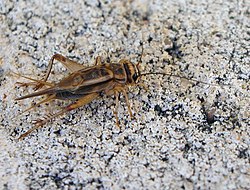| Acheta | |
|---|---|
 | |
| Acheta domesticus | |
| Scientific classification | |
| Kingdom: | Animalia |
| Phylum: | Arthropoda |
| Class: | Insecta |
| Order: | Orthoptera |
| Suborder: | Ensifera |
| Family: | Gryllidae |
| Subfamily: | Gryllinae |
| Tribe: | Gryllini |
| Genus: | Acheta Fabricius, 1775 [1] [2] |
| Species | |
See text. | |
| Synonyms | |
| |
Acheta is a genus of crickets. It most notably contains the house cricket (Acheta domesticus). According to Direction 46 issued by the ICZN in 1956, this generic name is masculine in gender. [3] Apart from the cosmopolitan house cricket, species are recorded from the Palaearctic realm and North America. [2]